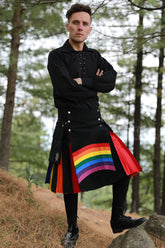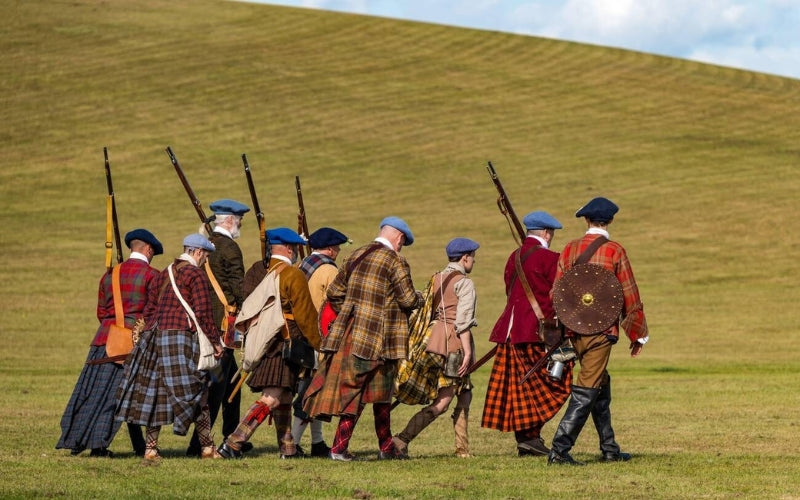Who Wears Kilts? Probing Cultural Significance Beyond Borders!
Kilts are a traditional garment that has been worn for centuries by various cultures around the world. They are a symbol of pride and heritage for many people, and their unique design and style have made them a popular fashion statement in modern times. In this blog, we will explore the history and cultural significance of kilts, as well as answer some common questions about who wears them.
What Country Wears Kilts?
Kilts are a type of traditional dress that originated in Scotland and are now worn in various countries around the world. Let’s explore the countries where kilts are commonly worn and the cultural significance behind them.
Scotland
Scotland is renowned for Scottish kilts, which are worn by various groups in formal and informal settings. Kilts are used in boy scouts, bagpipers, dancing, and festivals. Some areas use kilts as school uniforms. Historically, kilts are linked to Scottish Plaid, made of acrylic wool and features a tartan pattern, which is a unique pattern of crisscrossing stripes and colors that represents a particular Scottish clan or family.
Ireland
Kilts are integral to Irish culture and history. They originated in Ireland during the 5th-6th Century A.D. The Irish Léine is considered a predecessor to the kilt. The traditional kilt associated with Ireland is the Saffron Kilt, which is mustard yellow in color and often has shamrock appliques down the pleat. Saffron Kilts were first worn by the Irish military in the British Army during the twentieth century, and it’s the most widely worn kilt in Ireland today.
Spain
The Galicia region in Spain is known for wearing kilts (falda escocesa). This adoption is attributed to the Celtic occupation of the region. Spaniards often wear kilts during special occasions and events, blending their own cultural elements with the Scottish influence, creating a distinctive fusion of traditions.
Germany
Germany honors its roots with kilts and tartans, notably represented by the Coburg tartan, created in honor of Albert of Saxe-Coburg-qGotha. This historical connection underscores the importance of kilts in German cultural expression. Whether worn in ceremonial settings or to pay homage to specific historical figures, kilts continue to be a symbol of cultural pride in Germany.
Egypt
The wearing of kilt-like garments has ancient roots in Egypt, with the ancient Egyptians among the first to adopt such attire. These light wrap-around skirts were made from quality linen, reflecting the historical fashion sensibilities of this civilization. The enduring legacy of kilt-like garments in Egypt showcases the longstanding cultural significance of this attire.
Other Countries
Other countries that wear tartan kilts and related garments include Wales, Australia, Canada, France, England, Greece, New Zealand, Normandy, and the United States. These countries continue the traditions of their Irish, Scottish, and European settlers.
In conclusion, kilts are worn in various countries around the world, and each country has its unique history and cultural significance associated with the garment.
What Cultures Wear Kilts?
Kilts are primarily associated with Scottish culture, but similar garments have been worn in other cultures around the world. Here are some examples of cultures and regions where kilts or kilt-like garments have been historically worn:
- Scottish Kilts: Iconic garment in Scottish culture.
- Irish Kilts: Worn historically in Irish culture.
- Welsh Kilts: Traditional in Welsh heritage.
- Manx Tartan: Garment associated with the Isle of Man.
- Breton Kilts: Cultural attire in Brittany.
- Greek Fustanella: Traditional attire in Greece.
- Albanian Fustanella: Traditional Albanian garment.
- African Kilts: Existence of kilts in African cultures.
- Modern Fashion: Kilts incorporated into contemporary fashion.
- Balkan and Eastern European Kilts: Cultural attire in Balkan and Eastern European regions.
It's important to note that the design and purpose of kilt-like garments can vary widely among these cultures, and they may have different names and traditions associated with them.
Did the British Wear Kilts?
Kilts are not commonly worn by the British population at large. However, kilts hold cultural significance and are a distinctive element of Scottish traditional clothing. They are not a mainstream attire for the broader British community. Kilts are considered a notable aspect of Scottish heritage. British individuals, in general, do not adopt kilts as part of their everyday dress. The kilt first appeared as the belted plaid or great kilt, and it gathered momentum as an emblem of Scottish culture as identified by antiquarians, romantics, and others, who spent much effort praising the ancient and natural qualities of the kilt. King George IV had appeared in a spectacular kilt, and his successor Queen Victoria dressed her boys in the kilt, widening its appeal. The kilt became part of the Scottish national identity and the wider Celtic identity.
Do Americans Wear Kilts?
Kilt-wearing is common in various countries, and in the United States, kilts are worn for cultural or special occasions. Kilts are not typically part of everyday attire in the U.S. and are often associated with celebrations and traditions. The cultural significance of kilts varies between regions. With a large number of Scottish immigrants to the US in the 1700s, kilts have been prevalent in America since its conception. People wear American Kilt as an expression of their Scottish connection, for fashion, or even just for traditional Scottish events like Burns Night or highland games. Kilts are also used as an expression of American-Scottish identity and fashion expression.
What Religion Wears Kilts?
Kilts, the iconic Scottish garment, transcend religious boundaries in Scotland. Worn by individuals across diverse faiths, including Christians (both Protestant and Catholic), as well as smaller religious communities such as Jews and Muslims, kilts bear no exclusive religious affiliation. This attests to Scotland's rich tapestry of religious diversity. Rooted in tradition, kilts are a symbol of national pride rather than a religious insignia. In the dynamic religious landscape of Scotland, this traditional attire serves as a unifying cultural expression, fostering a sense of shared heritage among adherents of various faiths within the nation.
Global Appeal of Wearing & Kilt Buying
Kilts, related garments, and accessories are not limited to representing a specific race, family, country, or tradition. Wearing and kilt buying is not exclusive to individuals of Irish or Scottish descent; people worldwide can embrace kilts, emphasizing pride and respect. Scottish and Irish communities are generally accepting, not easily offended when individuals from diverse backgrounds wear kilts, as long as it is done with honor and dignity. Kilts serve as more than just a symbol; they hold value when worn for pure and honorable purposes. The act of wearing kilts transcends geographical and cultural boundaries, fostering a sense of global pride and unity. The Scottish and Irish communities encourage a broad perspective, welcoming people worldwide to adopt and celebrate their traditional attire.
FAQs
What is the historical significance of kilts in various countries?
Kilts have a rich history and are worn in diverse cultures worldwide. In Scotland, they are linked to the Scottish Plaid and associated with various activities, while in Ireland, the Saffron Kilt holds historical importance. Additionally, kilts are embraced in Spain, Germany, Egypt, and other nations, each reflecting unique cultural expressions and traditions.
Which cultures historically wear kilts or kilt-like garments?
While Scottish and Irish cultures are widely recognized for kilts, various other cultures, such as Welsh, Manx, Breton, Greek, Albanian, Balkan, Eastern European, African, and even modern fashion, have historical ties to kilt-like garments. Understanding the diversity of designs and purposes across these cultures enriches our appreciation for this iconic attire.
Did the British population historically wear kilts?
While kilts are not part of everyday attire for the broader British population, they hold significant cultural importance in Scotland. The historical evolution of kilts in Scotland, from the belted plaid to a symbol of national identity, showcases their unique role in Scottish heritage, distinct from broader British fashion traditions.
How common is kilt-wearing in the United States?
In the United States, kilts are not typical daily attire but are often worn for cultural or special occasions. The prevalence of kilts in America can be traced back to Scottish immigrants in the 1700s. Today, kilts are worn as a connection to Scottish roots, for fashion, and during traditional Scottish events, illustrating a blend of American and Scottish identity.
Is there a religious association with wearing kilts?
Kilts, being an iconic Scottish garment, transcend religious boundaries in Scotland. Worn by individuals of diverse faiths, including Christians, Jews, and Muslims, kilts are symbols of national pride rather than exclusive religious insignia. This inclusive tradition reflects Scotland's diverse religious landscape, fostering a shared heritage among adherents of various faiths.















